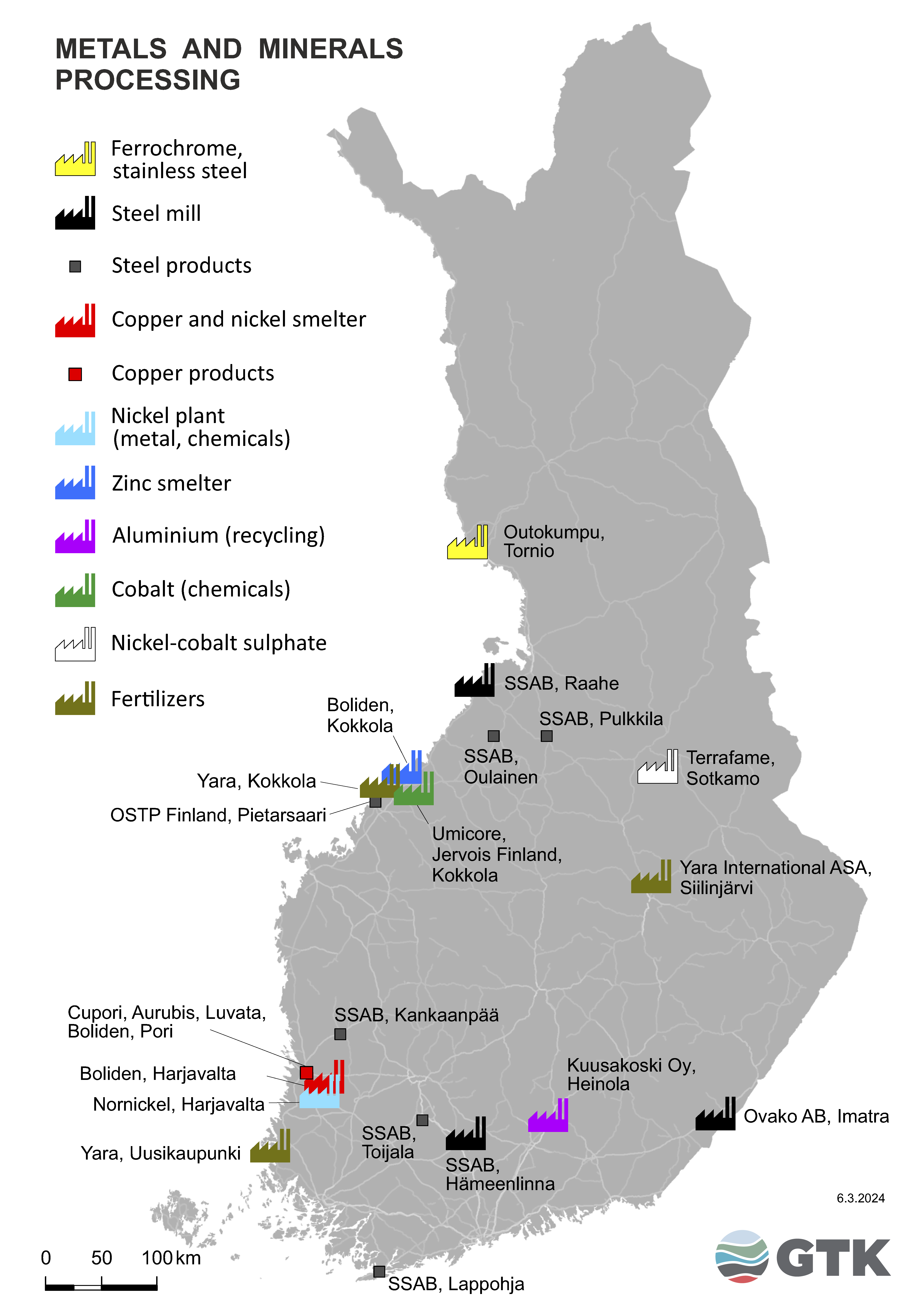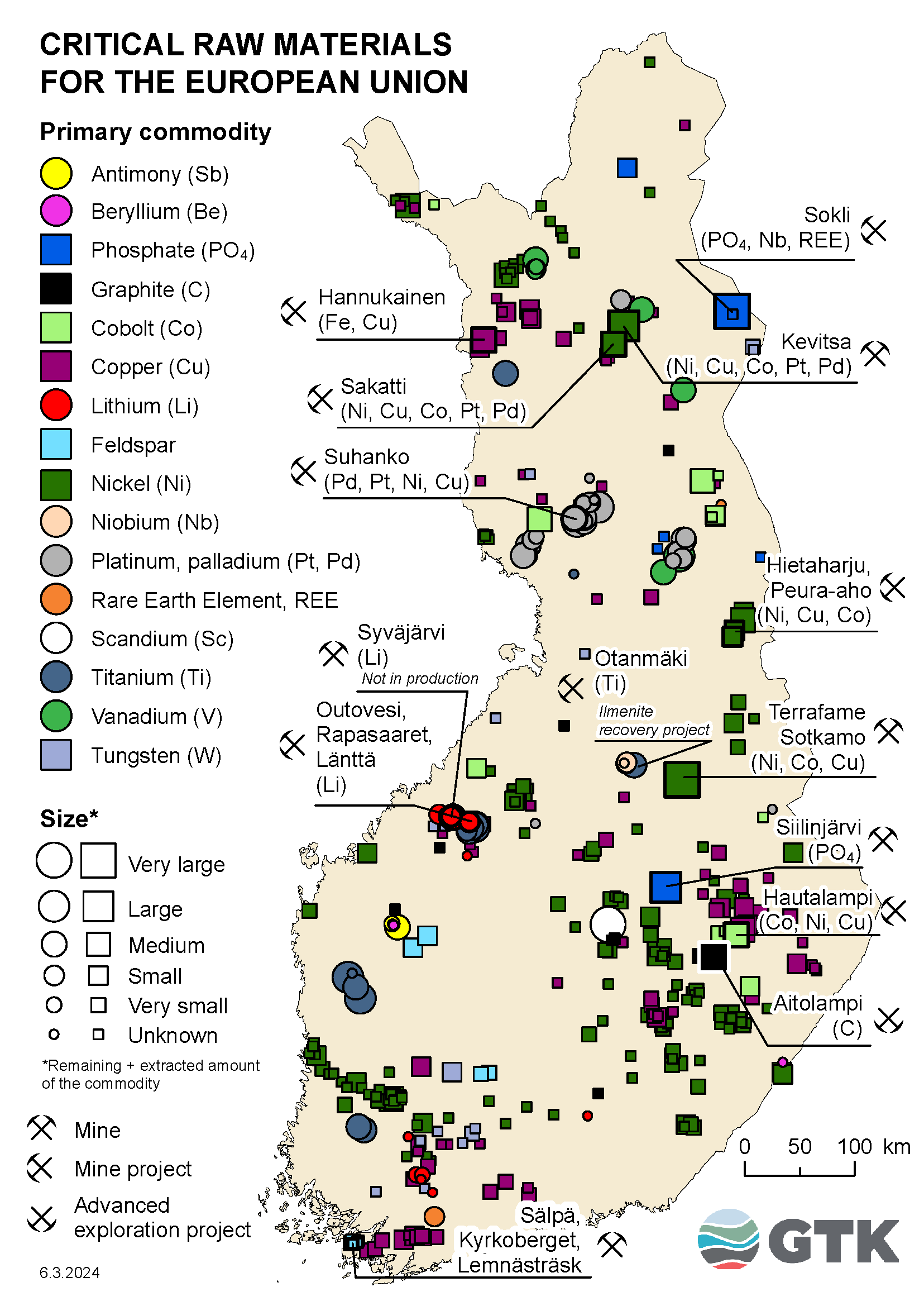Mining and deposit maps
This page contains a collection of thematic maps of Finnish mineral deposits, mines, and mineral and metal processing plants in PDF format. Mine maps are updated once a year, usually in April. The source of the mining data is the Finnish Safety and Chemicals Agency (Tukes). Other information related to companies mainly comes from the companies’ websites and press releases. The data source for mineral deposits is the GTK mineral deposit database.
More detailed information is available in map services
GTK’s extensive and detailed datasets on several different topics is available in browser-based map services. Among others, the Mineral Deposits and Exploration (MDaE) map application includes the Finnish mineral deposits, mines, data from the Finnish mining register maintained by Tukes, as well as a large number of different geological and geophysical maps as well as observation and measurement data.
Mines in Finland
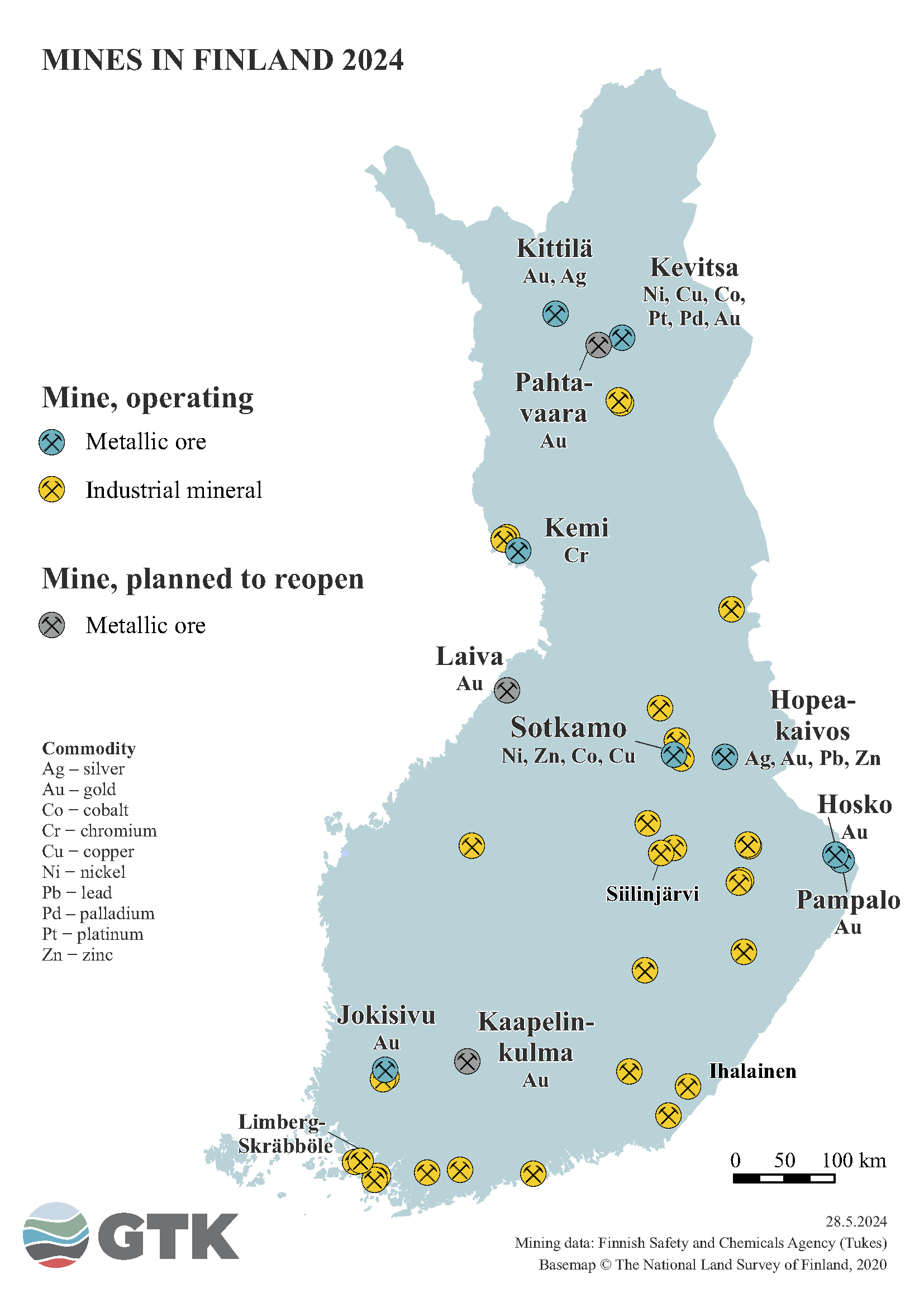
The map shows the metal and industrial mineral mines that were in operation at the time of the date and the mines that the companies have announced they are planning to reopen. Mines in operation refer to the mines that have reported mining activities to Tukes in the previous year. In addition, the companies’ notifications of the start or end of operations in a mine have been taken into account. The main product obtained from metal ores is a metal. All other mines and quarries subject to the Mining Act are depicted in this map as industrial mineral mines, which here include carbonate mines, industrial rock mines, soapstone mines and gemstone mines.
Mining projects in Finland
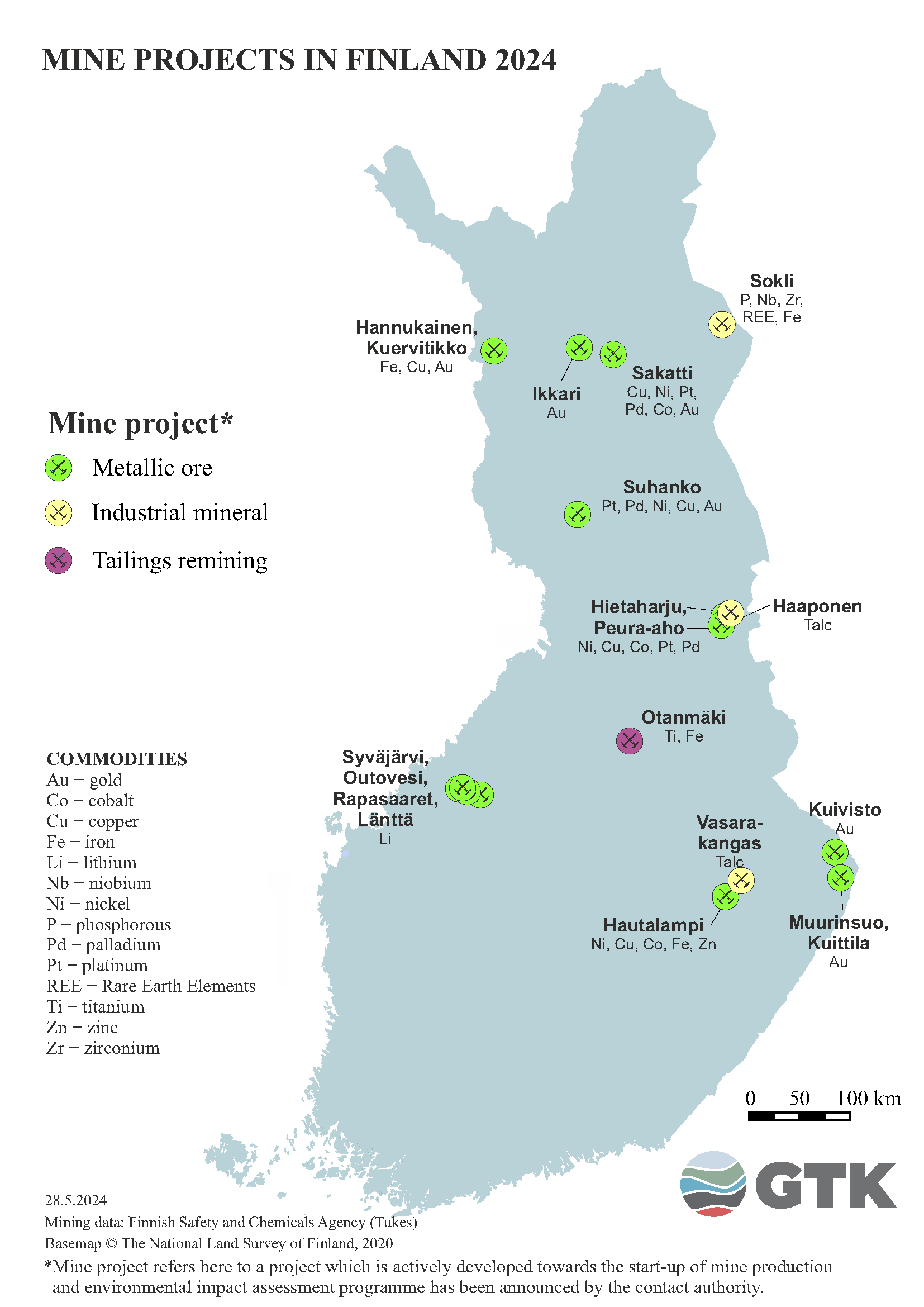
The map shows projects that have progressed to the mining project stage at the time of the date. In this context, a mining project refers to a project that the company is actively progressing towards the start of mining and whose planning has progressed so far that the contact authority has announced the project’s EIA programme. The map only lists the commodities whose planned production the company itself has announced. In addition to them, the deposits may also include commodities whose production is not planned. Information on all the commodities of the deposits is available, for example, in the GTK Mineral Deposit Database (MDaE).
REE stands for Rare Earth Elements. These include yttrium, lanthanum, cerium, praseodymium, neodymium, promethium, samarium, europium, gadolinium, terbium, dysprosium, holmium, erbium, thulium, ytterbium and lutetium. Sometimes scandium is also included in the group.
Mines and mining projects in Finland
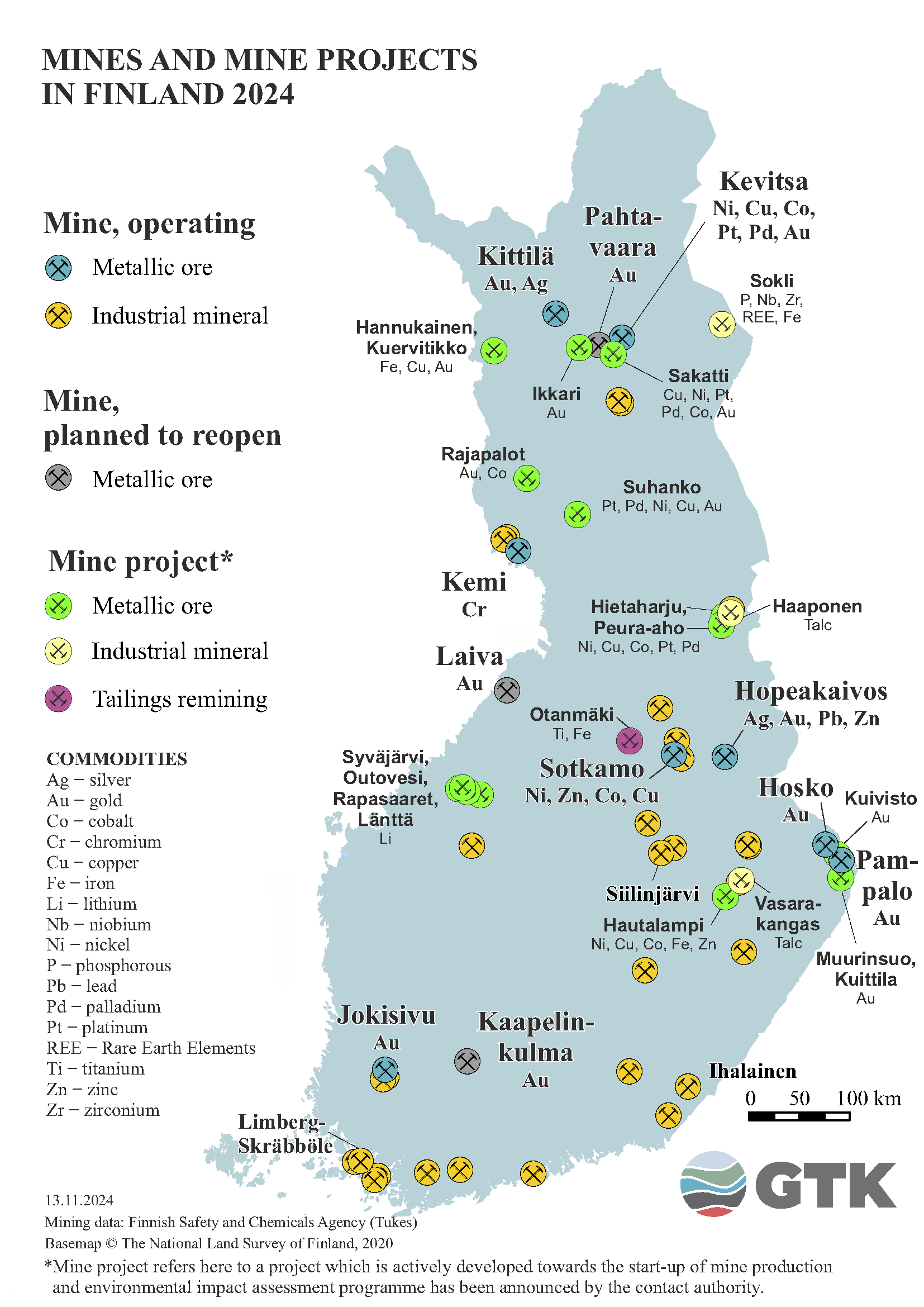
The map is a combination of the maps Mines in Finland and Mining Projects in Finland. The principles used in preparing the map are described in connection with these maps.
Ore mining in Finland
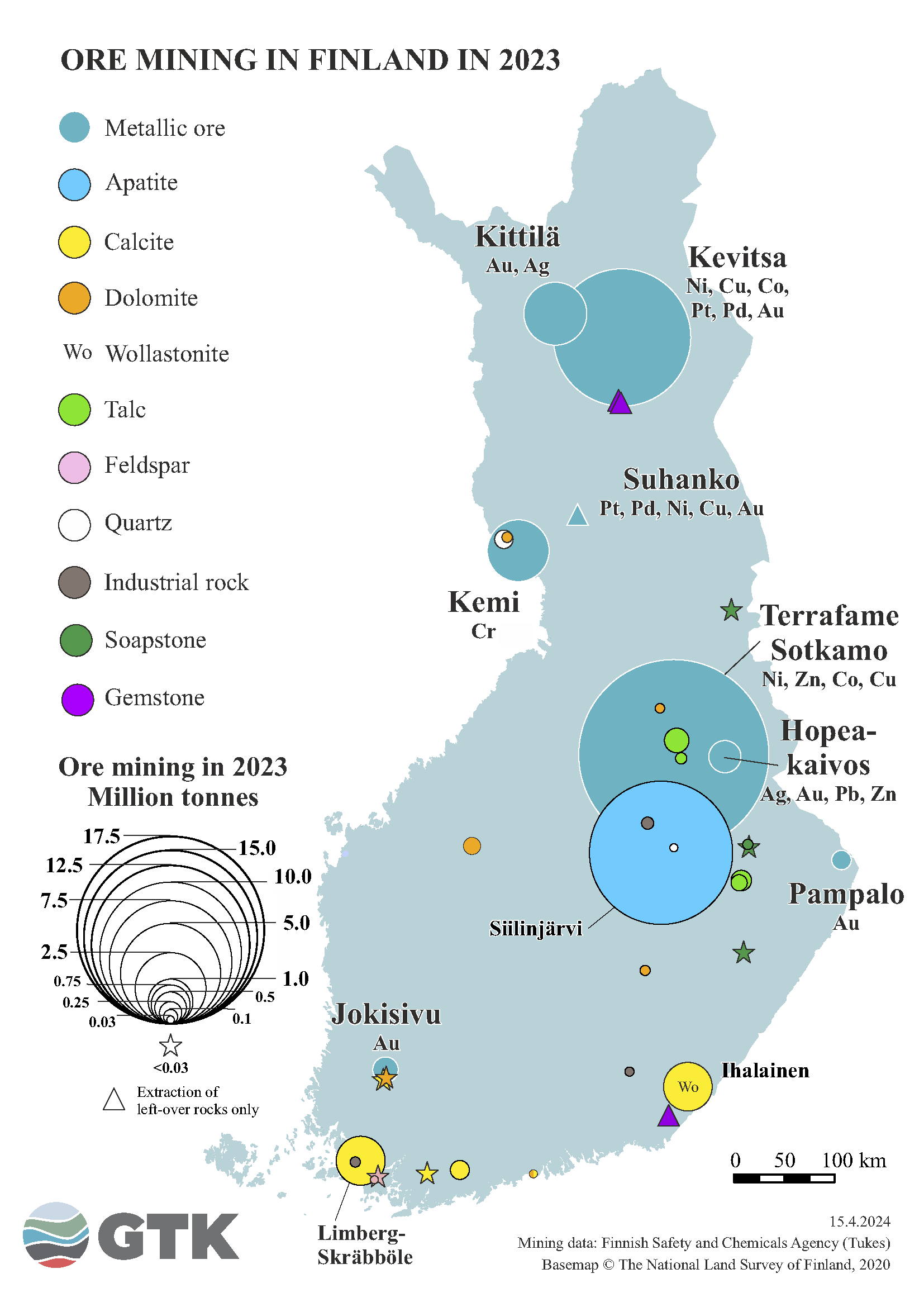
The map depicts the volume of ore extraction in Finnish mines reported by year. The map shows all mines that have reported mining to the Finnish Safety and Chemicals Agency (Tukes) for the year in question. In addition, there are mines in Finland that have not mined ore or waste rock during the year in question – such mines are not shown on the map. Companies have a statutory obligation to report the mining volumes of mining districts and mining permit areas annually to the mining authority (Tukes), which publishes the mining volumes in the spring of the following year.
In the map, the size of each circle is directly proportional to the tonnage of ore extracted from the mine during that year. The circles of different sizes presented in the map legend help understand the tonnage class as a figure. When the extraction volume of ore is less than 30,000 tonnes (i.e., less than 0.03 million tonnes), the mine is depicted with an oversized star symbol, because a circle drawn in the correct size would be very small.
Metal ore mines are presented with a turquoise symbol with a white border, and chemical labels indicate the commodities that the mine reports it has produced (or will produce). Commodities produced by others than metal ore mines are indicated with a colourful symbol with a black border (wollastonite’s letter symbol is Wo) and are listed in the map legend. Of these, only the three largest mines have been named on the map.
Mining of metallic ores
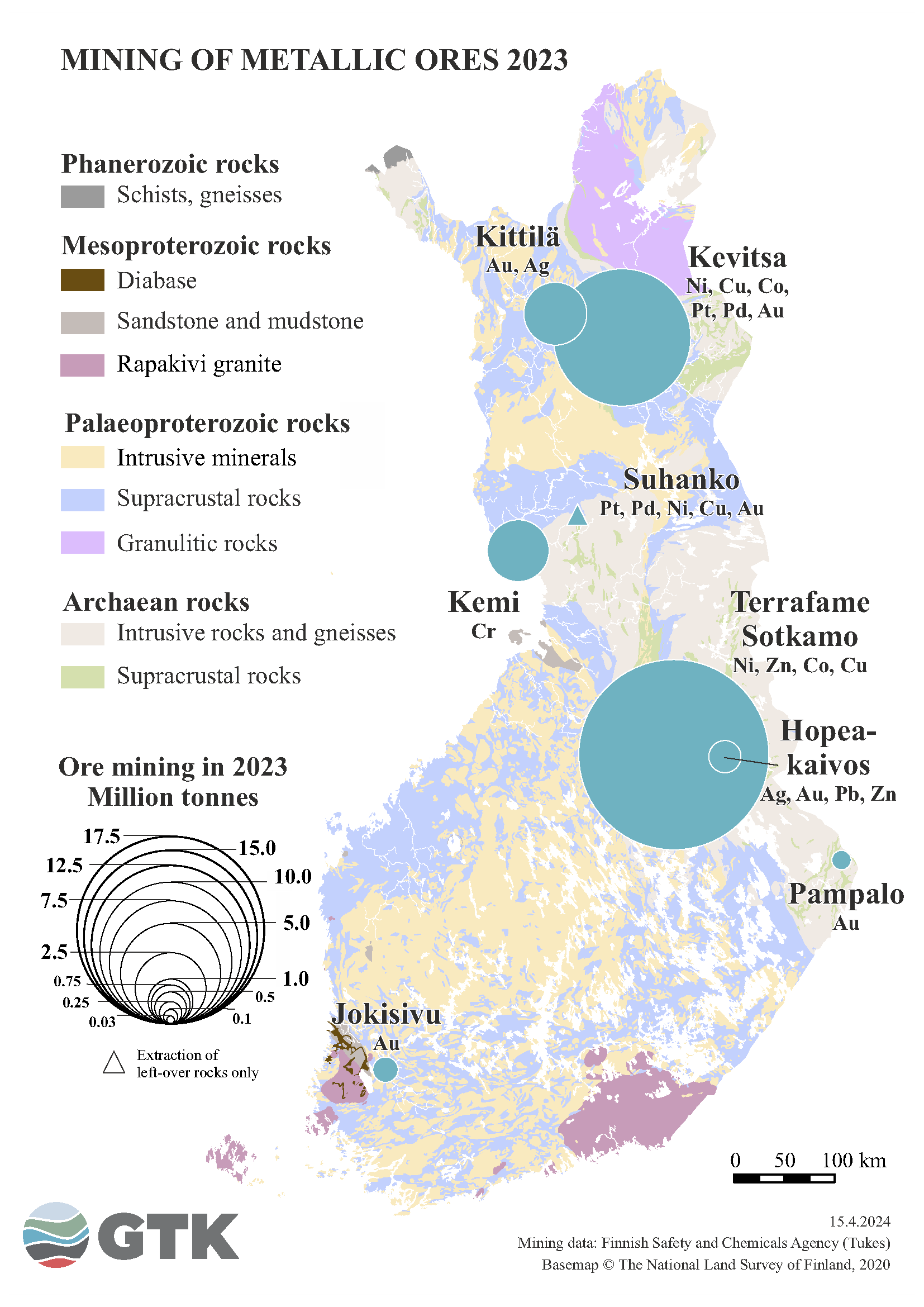
The map depicts the amount of ore mining in Finland’s metal ore mines in the year reported. The principles used in the preparation of the map are described in connection with the map “Ore extraction in mines”.
Mining of industrial minerals, gemstones and soapstones
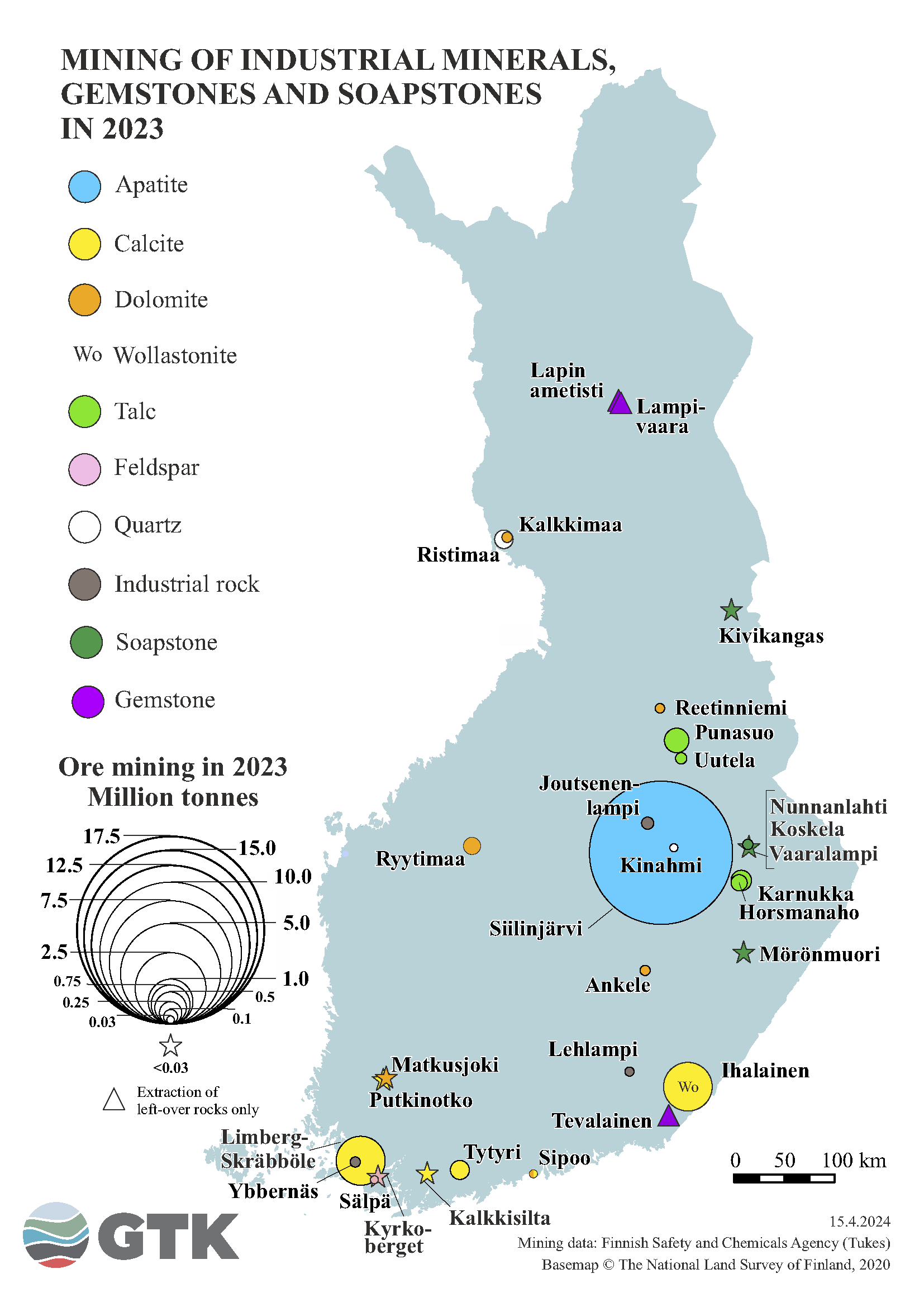
The map describes the volume of ore mining in the reported year in mines other than metal ore mines. In other words, it includes mines that extract industrial minerals, carbonates, industrial rocks, soapstone or gemstone. The principles used in the preparation of the map are described in connection with the map “Ore extraction in mines”.
Battery mineral mines and processing plants in Finland
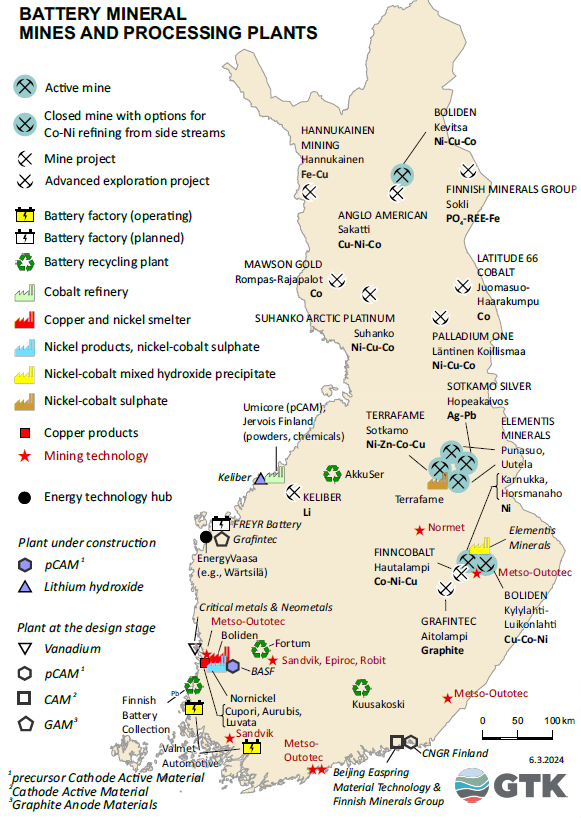
The map shows the most important battery mineral mines, mining projects, advanced ore exploration projects and processing plants in Finland. In addition, the map shows the production facilities of mining technology companies of global significance. On this map, battery minerals include graphite, silver, cobalt, copper, lithium, lead, nickel, iron and zinc. Only the battery metals or minerals produced or planned to be produced from the deposit are listed as commodities. In this context, a mining project refers to a project that the company is actively progressing towards the start of mining activities and whose planning has progressed so far that the contact authority has announced the project’s EIA programme. These conditions have not yet been met in an advanced ore exploration project.
Battery mineral deposits in Finland
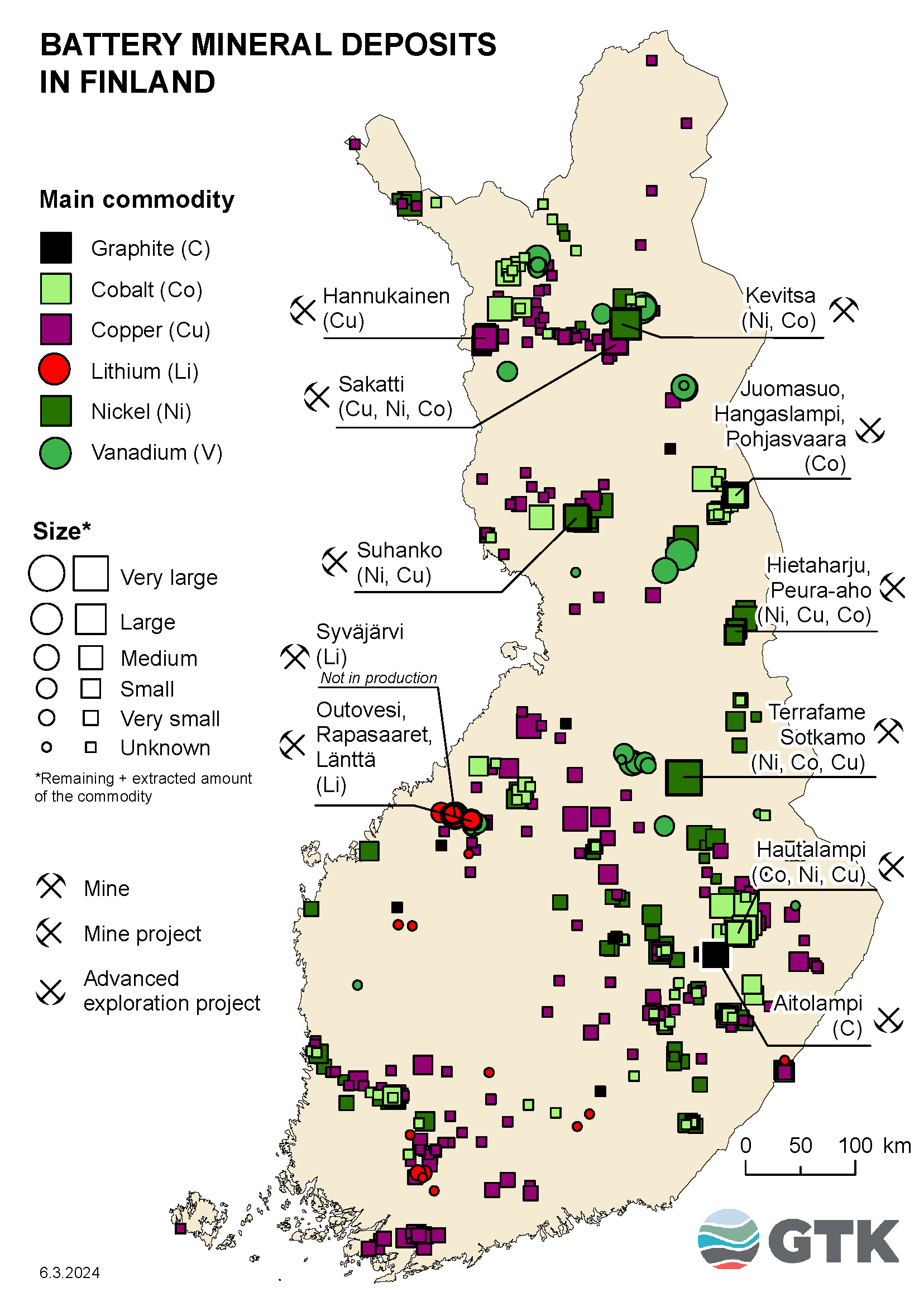
The map shows the deposits in the GTK mineral database whose main commodities include at least one of the key battery minerals, i.e., cobalt, lithium, graphite, nickel, copper, or vanadium. Some other metals or minerals can also be considered to be battery minerals, but they are not included in the map because they are not the most critical or they exist in the same deposits as those already marked on the map. The main commodities are considered to be up to two of the most important commodities in the deposit.
The colour symbol for each deposit indicates which of the listed battery minerals is considered the most important for the deposit in question. The size of the symbol indicates the size class of the deposit for that commodity according to the INSPIRE specification (see INSPIRE – Infrastructure for Spatial Information, Annex F). Under the name of the deposit, all of the six mentioned battery minerals that are produced or planned to be produced from the deposit are also listed in the brackets.
In this context, a mining project refers to a project that the company is actively progressing towards the start of mining activities and whose planning has progressed so far that the contact authority has announced the project’s EIA programme. These conditions have not yet been met in an advanced ore exploration project.
Mines, mining projects and advanced exploration projects containing critical raw materials in Finland
The map shows those deposits in GTK’s mineral database whose primary commodity is one of the raw materials identified as critical to the European Union. The commodity in question is represented by a colour symbol, and the size of the symbol indicates the size of the deposit for the commodity in question according to the INSPIRE specification (see INSPIRE Infrastructure for Spatial Information, Annex F). Under the name of the deposit, the parentheses also include other EU-critical raw materials that are produced or planned to be produced from the deposit. In addition to the deposits marked on the map, there are other mineral deposits in Finland where raw materials critical to the EU are found as main or secondary, but not as the most important commodity. For such deposits, only sites that have progressed to mining projects are shown on the map. This is the case, for example, of Hannukainen, whose main commodity is iron and not copper, which is a critical raw material for the EU.
A mining project here refers to a project that the company actively promotes towards starting mining production and whose planning has advanced to the point where the contact authority has announced the project’s EIA programme. In the advanced exploration project, these conditions have not yet been met.
Critical raw materials produced from the Finnish mines are:
- Phosphate (Silinjärvi)
- Cobalt (Terrafame, Kevitsa)
- Copper (Kevitsa, Terrafame)
- Nickel (Terrafame, Kevitsa)
- Platinum and Palladium (Kevitsa)
- Feldspar (Sälpä, Kyrkoberget, Lemnästräsk)
Note: Lithium is not yet produced, although on the map Syväjärvi has already been marked as a working mine.

